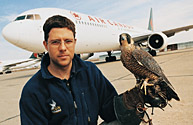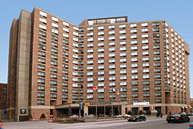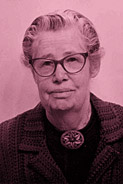Newsbites (Page 4)
Raptors on the Runway
 Montreal Mirror/Jason Feller Montreal Mirror/Jason Feller |
|
While pursuing his degree in wildlife biology at Macdonald Campus, Carl Millier, BSc (Agr)'94, struck up a friendship with Mark Adam, a technician working at Mac's Avian Science and Conservation Centre. Millier marvelled at Adam's remarkable rapport with the falcons he trained for release into the wild. Under Adam's tutelage, Millier (shown above) began mastering the medieval art of falconry himself.
As Millier approached graduation, he and Adam decided to put their expertise to work in an unusual way -- using birds of prey to protect aircraft from collisions with seagulls, geese and other birds and animals.
Such collisions result in $500 million worth of damages and related costs each year in the U.S. alone, and the majority of accidents occur during takeoffs and landings. "Airports spend a lot of money trying to find a solution," says Millier. "We knew there was a market for what we had to offer."
The pair's first contract, a pilot project at Dorval, was a stunning success -- airplane collisions with birds plummeted from 38 to 18. Today such incidents number about nine a year at Dorval. The duo's company, Falcon Environmental Services, also keeps runways clear at Toronto's Pearson Airport and Kennedy Airport in New York.
It's not unusual to find Millier at work at Dorval at sunrise, patrolling the runways with a falcon, on the lookout for feathered trespassers. A quick glimpse of a falcon is usually enough to send gulls and other birds packing. "I've seen a group of seagulls two kilometres away take off at the sight of a falcon. It's an instinctive reaction. We use the natural relationship between predators and prey," explains Millier.
Birds aren't the only form of wildlife found around airports. Coyotes, deer and other critters are often spotted where they shouldn't be. "Even a groundhog or a skunk can damage a plane's landing gear [in a collision]," explains Millier. "Falcons are bird hunters -- they use
altitude to dive down on their prey. To drive away mammals we use hawks, because they are more efficient hunters on the ground."
The company, which employs 22 falconers in all, offers other services. Birds trained by Falcon Environmental Services have appeared in such films as Lost and Delirious, Abandon and The Bone Collector. The company also designs educational programs, sending animators and raptors into schools for presentations. This summer, the firm's falcons, hawks, eagles and owls will entertain tourists visiting the summit of Mont Tremblant, north of Montreal.
"It doesn't matter if you're seven or 77," says an admittedly biased Millier. "Nothing compares to [the wonder] of seeing one of these birds spread their wings and take flight."
Residence Renaissance
 Owen Egan Owen Egan |
|
Flo Tracy's phone isn't ringing off the hook this summer and that's a good thing. In recent years, Tracy, McGill's director of residences and student housing, has been fielding a lot of calls from the nervous parents of new McGill students, anxious about helping their children secure lodging in Montreal.
McGill hasn't been able to keep pace with the growing demand for residence spots from out-of-province first-year undergraduates. The vacancy rate for Montreal apartments has plummeted in recent years and finding an affordable place to rent is much more difficult than it once was.
But things are looking up.
McGill recently purchased the Renaissance-Montreal Hotel and is currently converting the building into a new residence hall capable of housing about 650 students. Not only will McGill be able to guarantee a residence space to every new undergraduate from outside Quebec, it will also be able to offer about 200 residence spots to upper-year students as well.
McGill's newest residence is only a five-minute walk from the main campus and is also within easy strolling distance of McGill's athletics facilities, Mount Royal, grocery stores, a repertory movie theatre, restaurants -- not to mention the ample delights and diversions of Montreal's downtown core. "We couldn't have asked for a better location," says Tracy.
While the students who will occupy the new residence shouldn't come in expecting room service from their former hotel digs, they will have access to an on-site cafeteria. Each floor will feature kitchen and study areas and the students' fully furnished spaces will also boast air conditioning, big beds and their own bathrooms. Renovations are scheduled to be completed by mid-August.
Acquisition of the hotel was made possible by the $200 million raised when the University issued unsecured debentures to investors last fall. The number-one priority for this new source of funding was to bolster McGill's residence offerings. The shopping spree might not be over just yet. The University is actively looking into other possibilities for increasing its student residences to offer spaces to exchange students, first-year graduate students and more upper-year undergraduates.
Saluting a Stargazer
 Queen's University Queen's University |
|
Allie Vibert Douglas won plenty of awards during her remarkable life, but her latest honour is simply out of this world.
A crater on Venus has just been named after Douglas, BA'20, MSc'21, PhD'25, LLD'60, and it's an apt tribute since Douglas, who died in 1988, was a trailblazing astrophysicist. "She was a pioneer," says Quebec City astrophysicist Yvan Dutil. "She was the first person to get a degree in astrophysics in a Quebec university. The next one wasn't until 1972!"
Dutil stumbled onto Douglas's life story when he researched the history of his field in Quebec. He was so impressed that he lobbied the International Astronomical Union to honour Douglas's memory. The IAU's policy is to have Venusian craters bear the names of famous females. Sappho, Pocahontas, Simone de Beauvoir and Cleopatra are among the select members of this crater club.
Two things about Douglas struck Dutil. She played an important role in encouraging women to pursue science studies, especially during the 20 years in which she was Queen's University's Dean of Women. Douglas helped pave the way for female students to be accepted into medicine and engineering at Queen's. Dutil notes that Douglas also helped popularize stargazing in Canada, setting up amateur astronomy societies in Montreal and Kingston.
Douglas studied mathematics and physics as a McGill undergraduate. When the First World War broke out, she put her degree on hold to work in the London War Office as a statistician. In 1918, she was made a Member of the Order of the British Empire for contributions to the war effort. After earning a Master's degree from McGill, Douglas travelled back to England to study with Sir Arthur Eddington, a leading astronomer and, for about a decade, the only scientist in the world apart from Einstein who fully understood the notion of relativity. Douglas later became Eddington's biographer. After completing her PhD, she taught at McGill until 1939, when she was hired away by Queen's.
During her career, Douglas served as the president of the Royal Astronomical Society and studied the properties of stars. She became an Officer of the Order of Canada in 1967 and was chosen as one of the "10 Women of the Century" by the National Council of Jewish Women.


